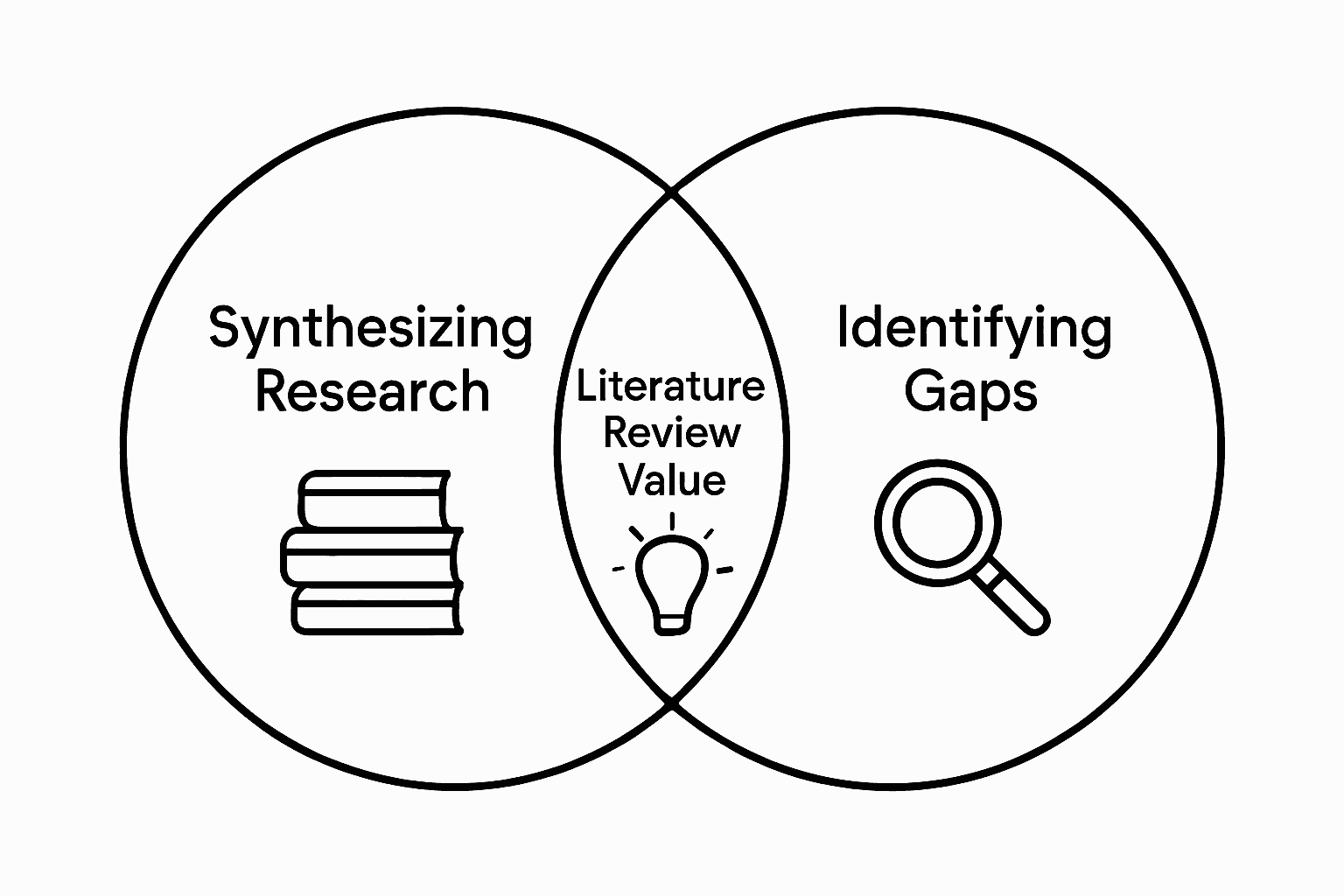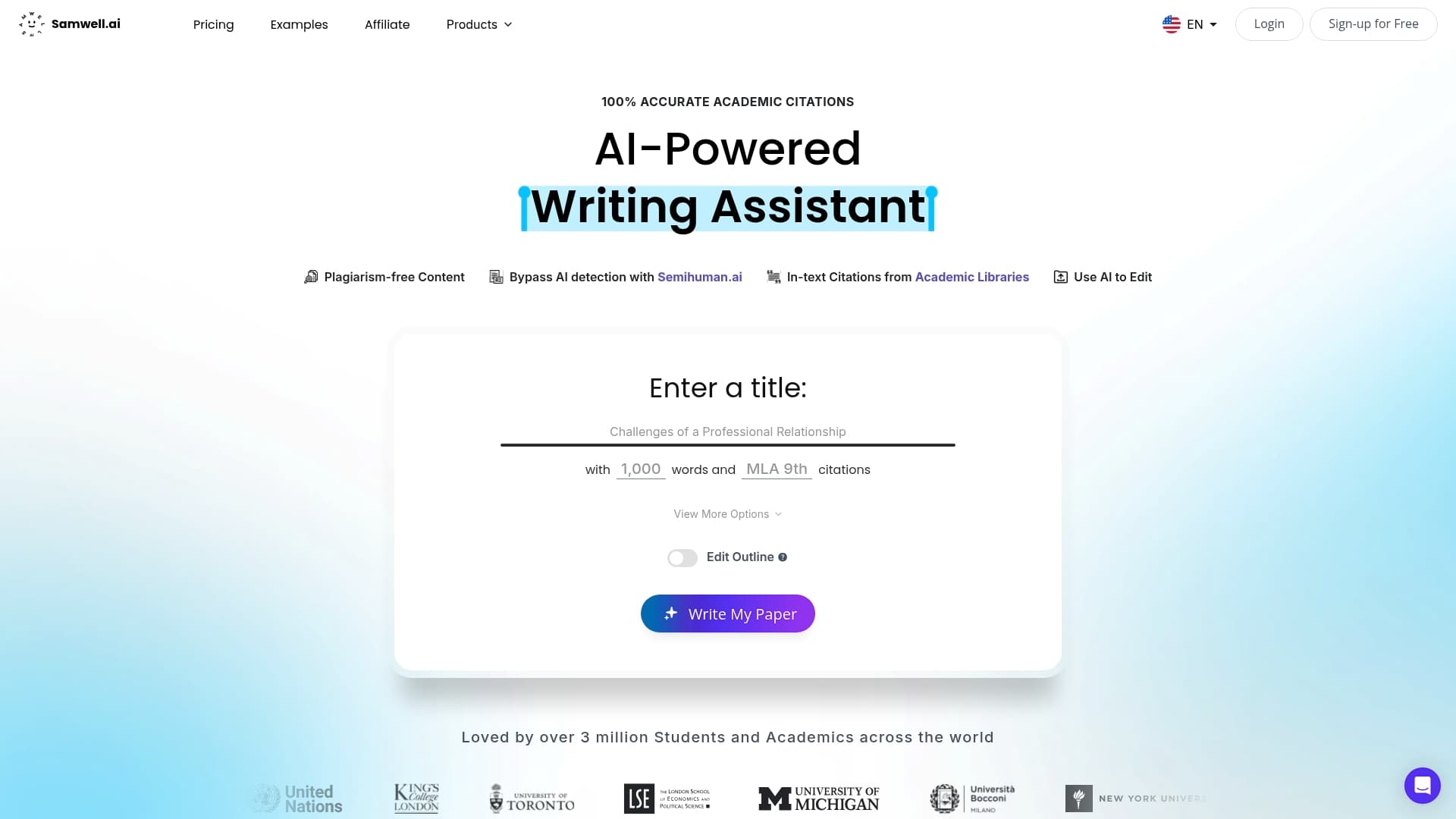Blog
Learning Materials
Understanding the Research Review of Related Literature
Updated: August 25, 2025

Every serious research project starts with one overlooked step: reviewing related literature. Everyone talks about the thrill of new discoveries and breakthroughs, but the act of mapping existing knowledge actually sets the stage for all the innovation that follows. Get this—researchers who conduct strong literature reviews are able to spot critical gaps and build on the shoulders of giants, which means systematic literature reviews often lead directly to new research breakthroughs while skipping unnecessary repetition. What makes this step even more surprising is how much it quietly powers the most impactful academic work you see today.
Table of Contents
- Defining The Research Review Of Related Literature Dockerfile README.md email-templates i18n-config.ts i18nConfig.ts next-sitemap-samwell.config.js next-sitemap-semihuman.config.js next.config.js node_modules package-lock.json package.json public scripts src svgr.d.ts translations tsconfig.json The Purpose Of A Literature Review Dockerfile README.md email-templates i18n-config.ts i18nConfig.ts next-sitemap-samwell.config.js next-sitemap-semihuman.config.js next.config.js node_modules package-lock.json package.json public scripts src svgr.d.ts translations tsconfig.json Scholarly Significance And Analytical Depth
- The Importance Of Reviewing Related Literature Dockerfile README.md email-templates i18n-config.ts i18nConfig.ts next-sitemap-samwell.config.js next-sitemap-semihuman.config.js next.config.js node_modules package-lock.json package.json public scripts src svgr.d.ts translations tsconfig.json Establishing Research Context And Credibility Dockerfile README.md email-templates i18n-config.ts i18nConfig.ts next-sitemap-samwell.config.js next-sitemap-semihuman.config.js next.config.js node_modules package-lock.json package.json public scripts src svgr.d.ts translations tsconfig.json Strategic Knowledge Development
- Key Concepts In Conducting A Literature Review Dockerfile README.md email-templates i18n-config.ts i18nConfig.ts next-sitemap-samwell.config.js next-sitemap-semihuman.config.js next.config.js node_modules package-lock.json package.json public scripts src svgr.d.ts translations tsconfig.json Foundational Research Strategies Dockerfile README.md email-templates i18n-config.ts i18nConfig.ts next-sitemap-samwell.config.js next-sitemap-semihuman.config.js next.config.js node_modules package-lock.json package.json public scripts src svgr.d.ts translations tsconfig.json Critical Analysis And Source Evaluation
- Navigating Sources And Identifying Gaps Dockerfile README.md email-templates i18n-config.ts i18nConfig.ts next-sitemap-samwell.config.js next-sitemap-semihuman.config.js next.config.js node_modules package-lock.json package.json public scripts src svgr.d.ts translations tsconfig.json Source Selection And Evaluation Strategies Dockerfile README.md email-templates i18n-config.ts i18nConfig.ts next-sitemap-samwell.config.js next-sitemap-semihuman.config.js next.config.js node_modules package-lock.json package.json public scripts src svgr.d.ts translations tsconfig.json Identifying Research Gaps And Opportunities
- Integrating Literature Review Findings Into Research Dockerfile README.md email-templates i18n-config.ts i18nConfig.ts next-sitemap-samwell.config.js next-sitemap-semihuman.config.js next.config.js node_modules package-lock.json package.json public scripts src svgr.d.ts translations tsconfig.json Thematic Organization And Synthesis Dockerfile README.md email-templates i18n-config.ts i18nConfig.ts next-sitemap-samwell.config.js next-sitemap-semihuman.config.js next.config.js node_modules package-lock.json package.json public scripts src svgr.d.ts translations tsconfig.json Conceptual Framework Development
Quick Summary
| Takeaway | Explanation |
|---|---|
| Literature reviews synthesize existing research. | They combine findings from various studies to provide a comprehensive overview of knowledge in a specific area. |
| Identify research gaps through critical analysis. | Understanding existing studies allows researchers to discover unexplored areas, enhancing the originality of their work. |
| Establish research context for credibility. | A thorough review positions new research within the academic discourse, demonstrating its relevance and importance. |
| Develop clear research strategies. | Formulating specific questions and criteria aids in systematically evaluating scholarly sources for relevance and quality. |
| Integrate findings into a coherent framework. | Successful literature reviews should connect insights from previous studies into a conceptual framework that supports new research directions. |

|
Defining the Research Review of Related Literature
A research review of related literature represents a systematic examination and comprehensive analysis of existing scholarly works connected to a specific research topic. Exploring scholarly sources helps researchers understand the current state of knowledge, identify research gaps, and establish a theoretical foundation for their investigations.
The Purpose of a Literature Review
The core purpose of a research review is multifaceted. It serves critical functions in academic and research environments by:
- Synthesizing existing research findings
- Identifying theoretical frameworks and methodological approaches
- Revealing potential research gaps or unexplored areas
- Providing context and historical perspective for new research initiatives
Researchers utilize literature reviews to demonstrate their understanding of the current scholarly landscape and position their work within the broader academic discourse. By critically analyzing previous studies, they can avoid duplicating existing research and contribute original insights to their field.
Below is a table summarizing the core purposes of a literature review, as described in the article. This helps clarify the multifaceted functions and benefits of conducting a thorough review of related literature.
| Purpose/Function | Description |
|---|---|
| Synthesize existing research findings | Combine results from various studies for a comprehensive overview |
| Identify theoretical frameworks | Uncover relevant theories that inform current research practices |
| Reveal potential research gaps | Highlight areas that have not been thoroughly studied or explored |
| Provide context and historical perspective | Place new research within the broader academic conversation and historical background |
| Demonstrate understanding of scholarly work | Show mastery of existing knowledge and analytical skills |
Scholarly Significance and Analytical Depth
A comprehensive research review goes beyond simple summarization. It requires critical analysis and intellectual integration of diverse scholarly sources. Researchers must evaluate the strengths, limitations, and interconnections between different studies, creating a nuanced understanding of the research topic.
Successful literature reviews demonstrate scholarly rigor by presenting a balanced, objective assessment of existing knowledge. Our comprehensive guide on academic research can help researchers develop the analytical skills necessary for conducting thorough literature reviews.
Ultimately, a well-constructed research review of related literature serves as an intellectual bridge, connecting past scholarly work with emerging research perspectives and paving the way for innovative academic discoveries.
The Importance of Reviewing Related Literature
A research review of related literature represents a strategic approach to understanding the comprehensive landscape of existing scholarly knowledge within a specific academic domain. Exploring systematic research methodologies enables researchers to build robust, well-informed academic investigations.
Establishing Research Context and Credibility
Reviewing related literature serves several critical functions in academic research. Researchers gain substantial benefits by systematically examining previous scholarly works:
- Identifying existing theoretical frameworks
- Understanding current research trends
- Recognizing methodological approaches and limitations
- Preventing unnecessary duplication of research efforts
By thoroughly analyzing prior studies, researchers demonstrate academic rigor and establish their work's foundational credibility. This process helps situate new research within the broader intellectual discourse, showing how current investigations connect with and advance existing scholarly understanding.
Strategic Knowledge Development
A comprehensive literature review enables researchers to map intellectual territories and uncover potential research gaps. According to research from the National Institutes of Health, literature reviews are crucial for scientific progression, allowing scholars to aggregate empirical findings, generate new theoretical frameworks, and identify unexplored research questions.
Moreover, literature reviews help researchers develop a nuanced understanding of their field, revealing complex interconnections between different studies and theoretical perspectives. This strategic approach ensures that new research builds upon existing knowledge rather than operating in isolation.
Ultimately, a well-executed literature review transforms scattered scholarly works into a coherent narrative, guiding researchers toward meaningful and innovative academic contributions.
Key Concepts in Conducting a Literature Review
Conducting a comprehensive literature review requires systematic planning, strategic analysis, and meticulous scholarly investigation. Mastering research methodology techniques enables researchers to navigate complex academic landscapes effectively.
Foundational Research Strategies
Researchers must develop robust strategies for identifying, evaluating, and synthesizing scholarly sources. Critical components of an effective literature review include:
- Formulating precise research questions
- Establishing clear inclusion and exclusion criteria
- Conducting comprehensive database searches
- Critically analyzing source credibility
- Synthesizing findings across multiple scholarly works
These strategic approaches ensure that the literature review provides a comprehensive and objective assessment of existing research within a specific academic domain.
Critical Analysis and Source Evaluation
Successful literature reviews demand rigorous intellectual scrutiny. According to research from the University of Southern California Libraries, researchers must go beyond simple summarization and engage in critical analysis.
This involves examining the methodological strengths and limitations of existing studies, identifying theoretical frameworks, and uncovering potential research gaps. Researchers must assess sources based on their scholarly merit, methodological rigor, and contribution to the broader academic discourse.
Ultimately, a well-executed literature review transforms disparate scholarly works into a coherent narrative, providing a solid foundation for future research and intellectual exploration.
Navigating Sources and Identifying Gaps
Navigating scholarly sources requires sophisticated research skills and strategic intellectual mapping. Developing advanced research techniques enables researchers to systematically explore and analyze complex academic landscapes.
Source Selection and Evaluation Strategies
Researchers must employ comprehensive strategies for identifying and assessing scholarly sources. Key considerations include:
- Evaluating source credibility and academic reputation
- Verifying publication dates and contemporary relevance
- Assessing methodological rigor and research design
- Cross-referencing multiple scholarly databases
- Examining citation networks and research impact
These strategic approaches ensure the selection of high-quality, authoritative sources that provide substantive insights into the research topic.
Identifying Research Gaps and Opportunities
Detecting research gaps represents a critical intellectual skill in academic scholarship. According to research from the National Institutes of Health, researchers must develop nuanced analytical approaches to uncover unexplored areas within existing scholarly literature.
Identifying research gaps involves critically examining existing studies to recognize:
- Methodological limitations in current research
- Theoretical inconsistencies or contradictions
- Underexplored demographic or contextual areas
- Emerging research questions not yet comprehensively addressed
By systematically mapping the intellectual terrain, researchers can position their work at the forefront of academic innovation, contributing meaningful insights that advance scholarly understanding.
The following table outlines key strategies for both evaluating sources and identifying research gaps during a literature review. This organization can help readers quickly see the steps and considerations involved in navigating the scholarly landscape.
| Strategy Type | Key Approaches |
|---|---|
| Source Evaluation | Assess credibility, verify relevance, check methodological rigor, cross-reference databases |
| Identifying Research Gaps | Examine for methodological limitations, theoretical inconsistencies, underexplored areas |
| Synthesizing Findings | Map themes, aggregate perspectives, identify patterns and contradictions |
| Ensuring Research Credibility | Situate new research within existing knowledge, avoiding unnecessary duplication |
Integrating Literature Review Findings into Research
Successfully integrating literature review findings requires sophisticated scholarly techniques that transform existing research into a coherent intellectual framework. Exploring advanced research integration methods empowers researchers to develop robust, well-informed academic investigations.
Thematic Organization and Synthesis
Researchers must strategically organize and synthesize literature review findings to create meaningful scholarly connections. Critical approaches include:
- Identifying recurring themes across multiple studies
- Mapping theoretical connections between different research perspectives
- Recognizing patterns and trends in existing scholarship
- Developing conceptual frameworks from aggregated findings
- Highlighting contradictions and areas of academic debate
These systematic approaches transform disparate research findings into a comprehensive intellectual landscape that contextualizes new scholarly contributions.
Conceptual Framework Development
Integrating literature review findings demands rigorous analytical thinking. According to research from the University of Delaware, researchers must view literature review findings as more than simple summaries, but as foundations for developing innovative conceptual frameworks.
Effective integration involves critically examining how existing research:
- Provides theoretical foundations for new investigations
- Reveals methodological innovations
- Suggests unexplored research directions
- Challenges existing academic assumptions
Ultimately, skillful integration of literature review findings enables researchers to position their work at the intersection of existing knowledge and emerging scholarly perspectives.

Transform the Way You Approach Literature Reviews
Struggling to keep up with the depth of analysis and critical evaluation required for a thorough research review of related literature? Many students and academics face the same problem. Integrating countless scholarly sources, identifying research gaps, and building a solid conceptual framework can feel overwhelming. The pressure to ensure accuracy, originality, and citation compliance only adds to the challenge.

Imagine simplifying your entire literature review process with smart technology that works with you. Samwell.ai empowers you to master every step mentioned in your article. Whether you need to synthesize complex findings, craft structured outlines, or expand your analysis, our advanced AI-driven tools like the Power Editor and Guided Essays make each task easier and more reliable. Take control of your academic writing today by visiting Samwell.ai and discover how you can achieve high-quality, credible work with less stress and better results. Start your journey now and elevate your next literature review into an expertly crafted foundation for your research.
Frequently Asked Questions
What is a research review of related literature?
A research review of related literature is a systematic examination and comprehensive analysis of existing scholarly works related to a specific research topic, helping researchers understand the current state of knowledge and identify research gaps.
Why is a literature review important for research?
A literature review is important because it synthesizes existing research findings, reveals theoretical frameworks, identifies research gaps, and provides context for new research initiatives, establishing credibility in the academic community.
How can I effectively conduct a literature review?
Effectively conducting a literature review involves formulating precise research questions, establishing inclusion and exclusion criteria, conducting thorough database searches, critically analyzing sources, and synthesizing findings across multiple studies.
What strategies help in identifying research gaps during a literature review?
Identifying research gaps involves critically examining existing studies for methodological limitations, theoretical inconsistencies, and underexplored areas, enabling researchers to position their work at the forefront of academic innovation.
Generate essays with Samwell.ai
Whether you’re a publisher, professor, journalist, or student, let us tailor a plan just for you.Most Read Articles

Your Guide to Help Writing a Essay Successfully
Expert tips for help writing a essay - from crafting a thesis to structuring your essay effectively.

How to Write Critical Thinking Essay: Expert Tips
Expert tips for writing a critical thinking essay. Learn how to structure, choose topics, and use evidence effectively.'

How to Write a Good Hook: A Step-by-Step Guide
Master the art of crafting a good hook with our guide. Create compelling openers for a memorable first impression.
